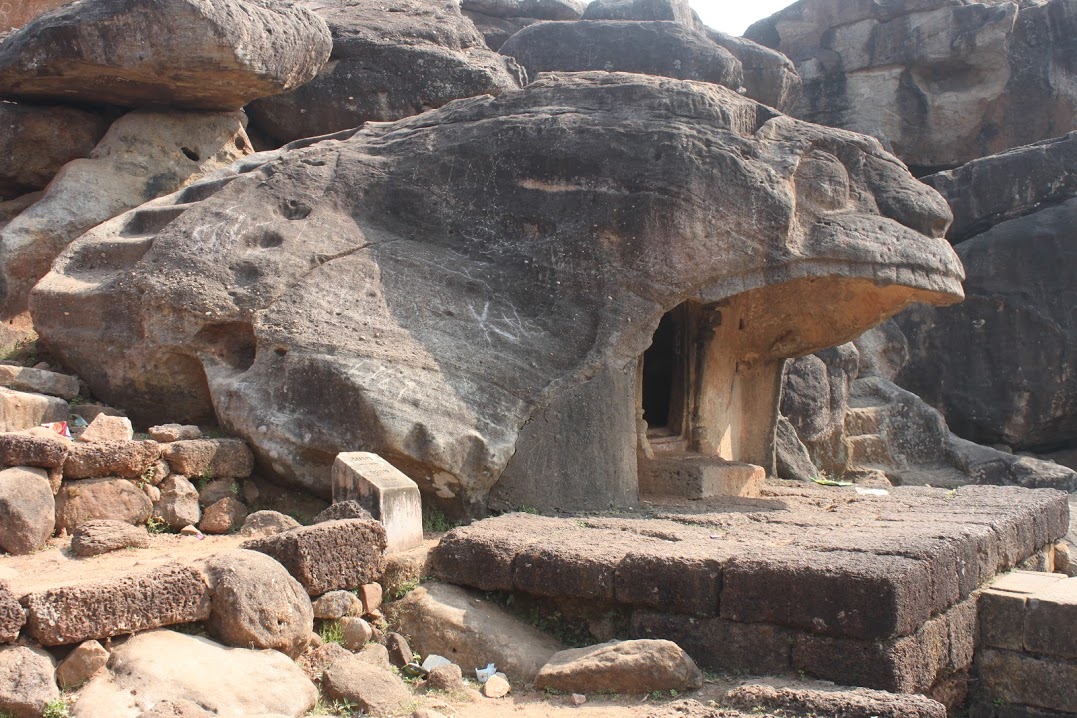Cave 11: Jamesvara-gumpha – This single cell cave has two entrances, and preceded by a benched verandah supported on two pillars. An inscription near an entrance door records that it was the cave of Nakiya, wife of Mahamada. Barua1 indicates to another translation, “The cave of (which is an excavation) of Mahamada, Bariya and Nakiya“. Barua tells that though Luders and Banerji took “Mahamada” as a personal name, however it may be some official designation. Based on this, he translates the inscription as, “The cave (which is an excavation) of the High Functionary Nakiya, of Bariya“.
Cave 12: Bagh-gumpha – Fergusson2 tells that guided by the architectural indications, it is probable that we may assume the Bagh-gumpha and Sarpa-gumpha caves to be the oldest among those in the complex. He writes that there seems no reason for doubting that this cave may not be only slightly more modern than the Hathi-gumpha (cave no 14) in the complex, and contemporary with those in the Barabar hills dating to Maurya period. Though it is commonly known as Bagh-gumpha, evidently due to the shape of the entrance, however Beglar3 mentions that it was known as Hathi-gopha as the people took its projecting façade as a head of an elephant.
The cave is constructed in shape of a tiger head, where its upper jaw-line makes the protruded shade above the entrance, while the cell is within its mouth. The door-jambs slopes inwards suggesting its early dating. The entrance pilasters have capitals of addorsed elephants. Above the pilasters is supported an arch, on either side of which is carved a railing. An inscription, starting with a triangular symbol, Barua4 identifies it with a tree and ending with swastika, records that it was the cave of the town-judge Bhuti. Banerji takes the name as Sabhuti or Subhuti.
Cave 13: Sarpa-gumpha – The cave is named so due to the three-hooded serpent head carved on the façade of the verandah. It is a single cell cave. It is presently not approachable as there is no staircase to reach here. There are two inscriptions. One over the doorway records name of two persons Chulakama and Kothaji, however Barua5 translates it as, “The facade and the unconquerable cells (which are athe meritorious works) of Chulakamma (Ksudrakarma)”. Banerji6 translates it as, “The unsurpassable chamber of Chulakama (Kshudrakarman)”.
The other on the left of the entrance is translated by Barua7 as, “The cells (which are excavations) of Karma and the facade (which is a meritorious work)of Khina.” Banerji translates it as, “The temple of Kamma and Halakshina”.
Notes:
1 Barua, B M (1929). Old Brahmi Inscriptions. University of Calcutta. Kolkata. pp 101-106
2 Fergusson & Burgess (1880). The Cave Temples of India. Oriental Books Reprints Corporation. Delhi. p 68-69
3 Beglar, J D (1882). Report of Tours in the South-Eastern Provinces in 1874-75 & 1875-76, vol. XIII. Archaeological Survey of India. New Delhi. p 93
4 Barua, B M (1929). Old Brahmi Inscriptions. University of Calcutta. Kolkata. pp 95-100
5 Barua, B M (1929). Old Brahmi Inscriptions. University of Calcutta. Kolkata. pp 79-82
6 Epigraphia Indica vol. XIII. pp 161-162
7 Barua, B M (1929). Old Brahmi Inscriptions. University of Calcutta. Kolkata. pp 91-94

